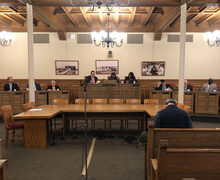Syracuse Stage’s ‘To Kill a Mockingbird’ highlights issues of racism, social inequality
Courtesy of Mike Davis
From left: Mark Murphey (Atticus Finch), Landon G. Woodson (Tom), Liam Craig (Heck Tate), Christopher McHale (Judge Taylor), John Keabler (Mr. Gilmer), and John Pribyl (Bob Ewell) in the Syracuse Stage production of "To Kill a Mockingbird."
During Syracuse Stage’s production of “To Kill a Mockingbird,” the Archbold Theater was no longer just a theater. It was a courtroom. Audience members were no longer mere spectators — they were jurors.
Adapted by Christopher Sergel from the classic Harper Lee novel, “To Kill a Mockingbird” debuted at the Syracuse Stage/SU Drama Complex this weekend. Told from the retrospective point of view of a lawyer’s daughter, the story highlights issues of injustice, racism and social inequality in the South during the 1930s.
The play features the older Jean Louise, who went by the name of Scout as a young girl, narrating the story. She guides the audience along an eventful summer in her childhood when her father, a lawyer named Atticus Finch, decides to defend a black man named Tom Robinson in court, who was wrongly accused of rape.
Scout, her brother Jem and their new friend Dill are intrigued by their mysterious neighbor named Boo Radley, and often speculate about him and his strange house. He doesn’t make an appearance until the end, when he comes out of his strange house and ultimately saves the children’s lives.
From the moment she stepped into the lone spotlight to give the opening monologue, Barbra Wengerd, who played Jean Louise, never left the stage. During scene transitions, she addressed to the audience and provided context to what was happening. But during the scenes that took place in the past, Wengerd was a fly on the wall, an invisible spectator watching and remembering the events of her childhood.
“As Jean Louise is telling the story, there are moments when she has a very adult consciousness about the story, and there are moments when she is totally transported back to when she was 8 years old,” Wengerd said. “It’s such a privilege, and it feels extra special to be like a proxy for Harper Lee.”
The production also featured three children who play the roles of Scout, her brother Jim and their friend Dill. The actors — Sera Bullis, Matthew Caraccioli and Anthony Crawley — are in eighth, seventh and sixth grade, respectively.
While the first act focused on setting the scene and getting the audience acquainted with the characters, the second act focused almost entirely on Tom’s trial. The audience became the jury, as the stage set changed from an outdoor porch to a full-fledged courtroom.
When it was time for Atticus to deliver his closing statement, Mark Murphey, the actor playing him, looked directly into the audience and addressed them. Every eye was focused on him as he delivered the play’s longest speech — an intense and passionate cry to acquit an innocent man.
“A court is only as sound as its jury, and a jury only as sound as the men who make it up. I’m confident that you gentlemen will review without passion the evidence you’ve heard, come to a decision and restore this defendant to his family,” Atticus says in the play. “In the name of God, do your duty.”
It was a delivery that had a few audience members almost stand up and start clapping.
“The professionalism in this show is just out of this world,” said John Keabler, who played Boo Radley and Mr. Gilmer, the prosecutor against Atticus. “Some of these actors have been working in professional theatre longer than I’ve been alive, which is amazing.”
Keabler also said he’s proud to be able to tell the story at this time, not only because of the memory of Harper Lee, who died exactly a week before the show’s opening night, but also because “To Kill a Mockingbird” is a timeless piece that relates to current issues in society.
“You can open any paper across this country, and you see that a minority is shot, or a minority is being talked badly about by a presidential candidate and wants to throw them across the border, Keabler said. “It’s so relevant right now, and we need to keep telling this story until something changes.”
Published on February 28, 2016 at 11:14 am
Contact Clare: clramire@syr.edu





